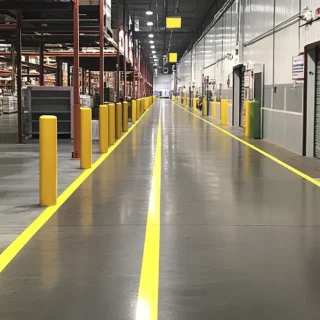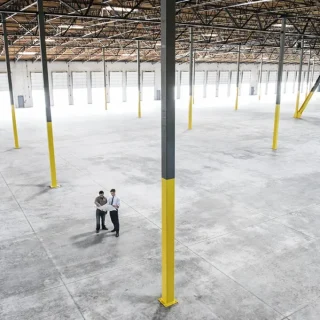En un negocio logístico dinámico, las etiquetas para el suelo del almacén pueden ser clave para garantizar la precisión y organización de las operaciones. Estas marcas se presentan en distintas variedades, se adaptan a las necesidades específicas del ecosistema de la instalación y complementan otras formas de señalización del suelo.
VER TAMBIÉN: Pintura de suelos de almacenes: todo lo que necesitas saber
Entre otras cosas, las etiquetas para el suelo del almacén desempeñan un papel crucial en la reducción de los tiempos de búsqueda, la agilización de los procesos de recolección y la mejora de la precisión general de los pedidos. Es esencial aprender a utilizar mejor las etiquetas para el suelo del almacén junto con otros sistemas de señalización, como el marcado de suelos 5S, para lograr la máxima eficacia.
Contáctanos si necesitas ayuda con el etiquetado o la señalización de almacenes en Brasil, México o Estados Unidos.
Ventajas de las etiquetas para el suelo del almacén
Las etiquetas para el suelo del almacén sirven como un sistema visual que guía a los empleados que utilizan maquinaria y comprueban el inventario dentro de un negocio logístico. Son marcas colocadas en el suelo que proporcionan información clave, como la ubicación, las zonas de almacenamiento, los pasillos y las zonas de seguridad. Estas etiquetas facilitan el desplazamiento eficaz.
Permiten dividir los almacenes en zonas y secciones designadas. Esta división favorece el almacenamiento sistemático y la fácil recuperación de los artículos del inventario. Con un etiquetado claro, los empleados pueden localizar rápidamente los artículos, lo que aumenta la productividad y ayuda a cumplir las normas de seguridad para almacenes, como las indicaciones de la OSHA para Estados Unidos.
Las etiquetas para el suelo del almacén, que suelen utilizar códigos de barras, ayudan a realizar un seguimiento de los niveles de inventario, reduciendo los casos de exceso de existencias o roturas de stock con sólo escanearlas. De este modo, es menos probable que los empleados cojan los artículos equivocados o los coloquen mal, lo que se traduce en menos errores de envío y devoluciones.
Los nuevos trabajadores pueden comprender rápidamente la distribución del almacén gracias a las indicaciones visuales que proporcionan las etiquetas para el suelo del almacén. Un sistema de etiquetado de suelos bien hecho debe ser muy fácil de leer para que la gente pueda obtener la información con un simple vistazo. Las personas pueden tomar decisiones adecuadas en todos los ámbitos, desde la seguridad hasta la organización.
Tipos de etiquetas para el suelo del almacén
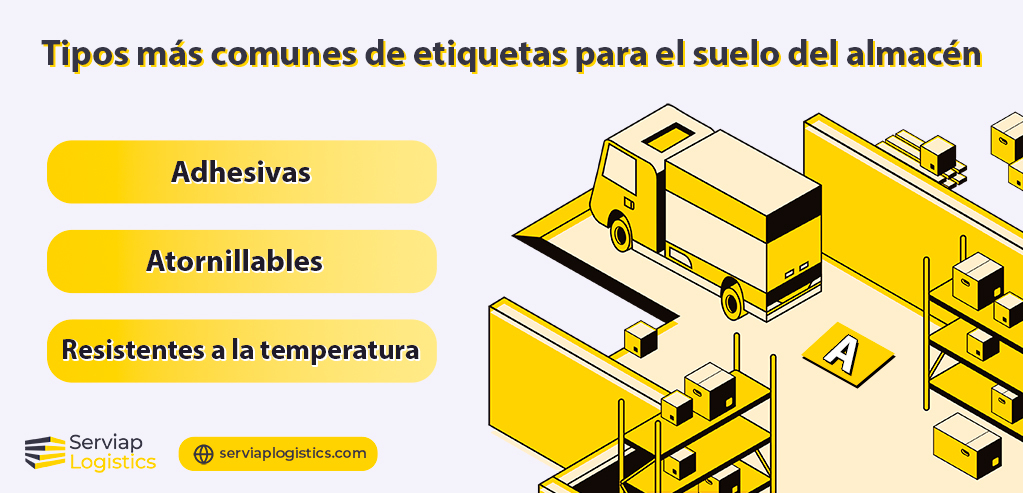
El tipo más común de etiquetas para el suelo del almacén es la adhesiva despegable. Es la opción más rápida para la aplicación. Si por cualquier motivo es necesario cambiar la etiqueta del código de barras, puedes quitarla rápidamente y volver a ponerla. Es importante informarse de la resistencia de la etiqueta a los productos químicos y a la abrasión, en función de la afluencia de tráfico en las zonas donde se vaya a instalar.
Otra opción es utilizar etiquetas para el suelo del almacén atornilladas. La etiqueta preimpresa se coloca bajo un marco de aluminio que puede fijarse al suelo mediante cuatro anclajes. El bastidor ofrece protección adicional frente a palés, trabajadores y tráfico de vehículos. Sin embargo, la instalación y reaplicación requieren más tiempo y herramientas adecuadas, como destornilladores.
Si aún deseas añadir otra capa de protección a las etiquetas para el suelo del almacén sin que se peguen a los marcos de aluminio, puedes utilizar protectores transparentes. Se aplican sobre la etiqueta instalada para aumentar su durabilidad sin comprometer la legibilidad de la información impresa. Estos protectores suelen ser de cinta adhesiva flexible o de plástico transparente rígido.
Además, para optimizar la durabilidad, considera la posibilidad de utilizar material de etiquetado especial para instalaciones específicas, como un almacén frigorífico. Para las zonas de congelación, las etiquetas para el suelo del almacén deben estar fabricadas con materiales que soporten las bajas temperaturas. Esto garantizará que las etiquetas no empiecen a despegarse con el tiempo debido a las condiciones de temperatura y humedad.
Consejos de aplicación y mantenimiento
En un almacén puede haber muchas zonas de tráfico intenso, por lo que puede ser necesario elegir varios estilos de etiquetas para lograr una cobertura óptima. Pero, más allá de decidir qué etiquetas para suelos del almacén aplicar en las instalaciones, también debes centrarte en la aplicación de las etiquetas y en la mejor forma de conservarlas.
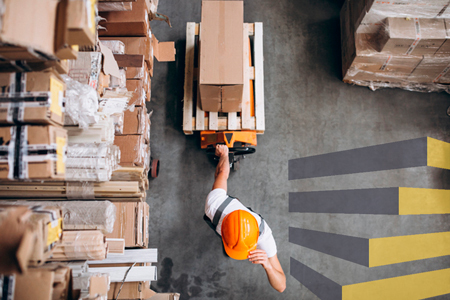
Asegúrate de que el suelo está limpio y seco. En las zonas de congelación, también es esencial desinfectar la superficie del suelo antes de la aplicación y sólo llevar las etiquetas al congelador cuando esté listo para aplicarlas y así obtener el máximo rendimiento. Las etiquetas deben colocarse con cuidado para evitar arrugas o pliegues, ya que esto puede comprometer su vida útil.
Tras la instalación, es importante saber qué hacer en caso de que se ensucien. Las etiquetas pueden limpiarse, pero no resisten productos químicos fuertes, ya que suelen venderse a bajo precio. En el mantenimiento regular, debes mantenerlas limpias con la menor cantidad posible de productos químicos. Si las manchas son más profundas, puedes recurrir a los servicios profesionales de limpieza de naves industriales.
Además, vale la pena organizar el flujo de tráfico para que los vehículos y las personas no sigan circulando o pisando las etiquetas innecesariamente. Es aconsejable colocar las etiquetas a la izquierda o a la derecha de la entrada de un lugar para evitar impactos continuos. Aunque las etiquetas para suelos del almacén están hechas para durar, estos hábitos pueden ayudar a prevenir el desgaste a largo plazo.
Otras formas de etiquetado de almacenes
Antes de colocar etiquetas para el suelo del almacén, recuerda que debes optimizar la gestión de todo el proyecto del negocio logístico. Los códigos de las etiquetas deben ser intuitivos, ya sea en el suelo o en otros espacios como pasillos y estanterías. Es esencial que la colocación sea uniforme y siga un plan de posicionamiento coherente.
Estanterías
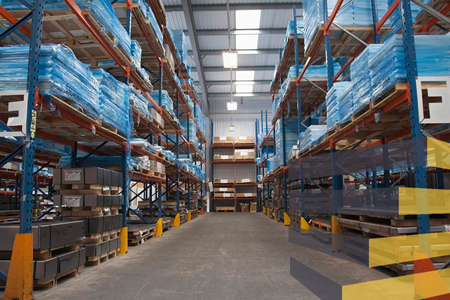
El etiquetado del almacén en las estanterías determinará el método de identificación de estos equipos de almacenamiento, que suelen distribuirse por unidades o secciones. Puedes etiquetar las estanterías de la forma estándar o con el patrón de serpentina. En el primer caso, los productos se etiquetan en una estructura paralela y de manera secuencial. Con el método serpenteante, los recolectores recogen los productos de un lado a otro del pasillo, en un movimiento en zigzag.
Pasillos
Estas etiquetas ayudan a identificar los pasillos y dan indicaciones, como el sentido de circulación o las salidas de emergencia. Se colocan en la parte superior de las estanterías o también pueden suspenderse del techo. Además, se basan en una numeración o secuencia de caracteres. Suelen fijarse como etiquetas adhesivas de doble cara o con tornillos en los estantes.
Productos
Los productos deben etiquetarse cuando llegan para optimizar la organización desde el principio. Esto ayuda a obtener información sobre los artículos, los lotes y otros aspectos de la manipulación. Las etiquetas individuales pueden ser etiquetas de contenido, que suelen llevar un código de barras y una descripción de la mercancía. Además, también pueden contener instrucciones de manipulación, especialmente para materiales delicados o peligrosos.
Serviap Logistics te ayuda con las etiquetas para suelos del almacén
Serviap Logistics ofrece una gama de servicios de instalación de almacenes en Brasil, México y Estados Unidos. Podemos ayudarte con los sistemas de etiquetado, incluidos aquellos que se colocan en el suelo, las estanterías, los pasillos y los productos.
También suministramos e instalamos estanterías de almacén, protección contra colisiones, limpieza industrial, señalización y mucho más. Con nuestros servicios de gestión de proyectos, podemos supervisar la instalación, el reacondicionamiento y la reubicación.
Nuestros clientes proceden de una amplia gama de sectores, como la venta al por mayor, el comercio electrónico y la automoción. Mantenemos los más altos estándares de seguridad, incluyendo la certificación OSHA, así como las regulaciones ABNT en Brasil y NOM en México.
Contáctanos para obtener más información sobre la aplicación eficaz de etiquetas para suelos del almacén y mucho más.


